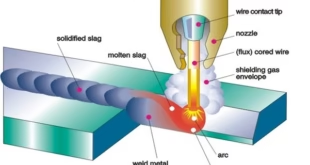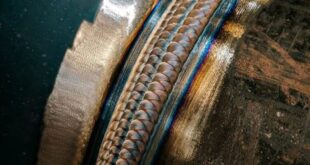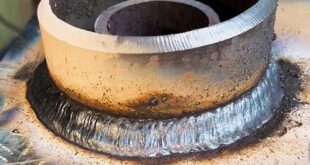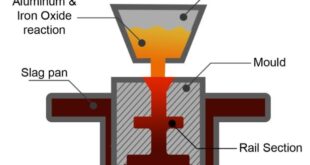What is Electroslag Welding?
Introduction
Electroslag welding is a specialized welding process that offers numerous advantages in specific applications. In this comprehensive guide, we will delve into the intricacies of electroslag welding, exploring its definition, process, applications, benefits, limitations, and more. Whether you are a welding enthusiast, a professional welder, or simply curious about this unique welding technique, this article will provide you with valuable insights into the world of electroslag welding.
What is Electroslag Welding?
Electroslag welding is a fusion welding process used to join thick sections of metal. It is particularly suitable for welding vertical or near-vertical joints between steel plates that are too thick for other welding methods. The process involves the melting of a consumable electrode and a portion of the base metal, creating a molten slag that shields the weld pool and promotes efficient heat transfer.
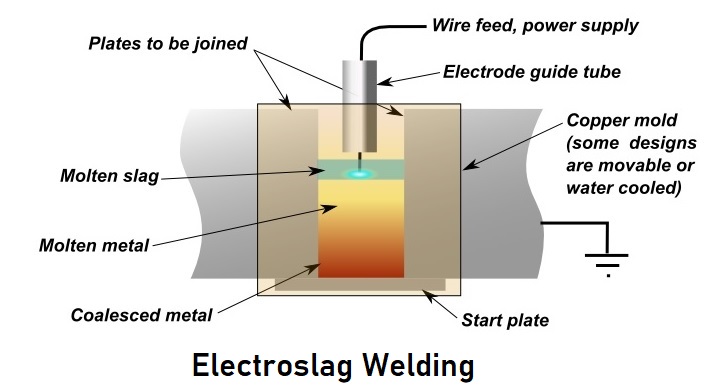
The Electroslag Welding Process
The electroslag welding process can be summarized in the following steps:
- Preparation: Before the welding process begins, the surfaces to be welded are thoroughly cleaned and properly aligned. The joint is typically V-shaped or U-shaped to facilitate the flow of molten metal.
- Electrode Placement: A consumable electrode, usually made of a specialized flux-cored wire, is positioned between the workpieces. It is important to ensure proper electrical contact and alignment for an effective weld.
- Slag Formation: A layer of granulated flux, which acts as a protective medium, is spread over the electrode and the joint. This flux protects the molten metal from atmospheric contamination, stabilizes the arc, and facilitates the transfer of heat.
- Current Application: Once the electrode and flux are in place, an electrical current is applied to the electrode. The current generates intense heat that melts both the consumable electrode and a portion of the base metal.
- Slag Melting: As the molten metal rises, it encounters the granulated flux, which rapidly melts, creating a conductive slag pool. This conductive slag pool plays a crucial role in heat transfer and shielding the weld pool.
- Weld Pool Formation: The conductive slag pool effectively transfers heat to the base metal, causing the edges of the joint to melt and form a molten weld pool. The molten weld pool is protected by the slag, preventing oxidation and maintaining the integrity of the weld.
- Solidification: As the welding process continues, the molten weld pool solidifies, forming a strong and durable joint between the workpieces. The resulting weld exhibits excellent penetration and fusion, ensuring the structural integrity of the welded components.
Applications of Electroslag Welding
Electroslag welding finds applications in various industries where the joining of thick metal sections is required. Some of the key applications include:
- Shipbuilding and Offshore Structures: Electroslag welding is commonly used in the construction of ship hulls, offshore platforms, and other marine structures. Its ability to produce high-quality welds in thick steel plates makes it an ideal choice for these demanding applications.
- Pressure Vessels and Storage Tanks: The process is widely utilized in the fabrication of pressure vessels, storage tanks, and other containers that handle high-pressure fluids or gases. Electroslag welding ensures the strength and integrity of these critical components.
- Bridge Construction: Electroslag welding plays a vital role in joining thick steel girders and plates in bridge construction. The process provides efficient and reliable welds, contributing to the structural integrity and longevity of bridges.
- Nuclear Power Plants: Electroslag welding is preferred for welding critical components in nuclear power plants, such as reactor vessels and containment structures. The precise and robust welds produced by this process ensure the safety and reliability of these vital installations.
- Heavy Machinery and Equipment: The fabrication of heavy machinery and equipment, including cranes, bulldozers, and mining equipment, often involves the use of electroslag welding. The process enables the creation of strong and durable welds in thick metal sections.
- Rail and Transportation Industry: Electroslag welding is widely employed in the manufacture and repair of rail tracks, locomotives, and other rail-related components. The process ensures the integrity and longevity of the welded connections in the demanding rail environment.
- Oil and Gas Pipelines: Electroslag welding is utilized for welding large-diameter pipes used in oil and gas pipelines. The process ensures reliable and leak-free connections, contributing to the safety and efficiency of the pipeline infrastructure.
Advantages of Electroslag Welding over Traditional Processes
Electroslag welding offers several advantages over traditional welding processes, making it a preferred choice in certain applications. Here are some key advantages:
- High Deposition Rates: Electroslag welding allows for high deposition rates, meaning that a significant amount of weld metal can be deposited in a relatively short time. This leads to increased productivity and reduced welding time compared to traditional processes.
- Deep Penetration: Electroslag welding provides deep penetration into the base metal, resulting in strong and reliable welds. This is particularly beneficial for welding thick sections where achieving sufficient penetration can be challenging with other processes.
- Minimal Weld Preparation: Electroslag welding requires minimal weld preparation, saving time and effort. Unlike traditional processes that often require extensive cleaning, bevelling, or edge preparation, electroslag welding can be performed on relatively rough or imperfect surfaces.
- Reduced Heat Input: Electroslag welding minimizes heat input to the base metal, which helps to reduce distortion and the risk of metallurgical issues such as heat-affected zone (HAZ) cracking. This is advantageous when welding materials prone to distortion or those with strict heat input requirements.
- Efficient Material Utilization: Electroslag welding utilizes a consumable electrode that melts and forms part of the weld metal. This reduces the need for additional filler material, resulting in efficient use of materials and potential cost savings.
Limitations of Electroslag Welding
While electroslag welding offers several advantages, it also has certain limitations that should be taken into consideration:
- Thick Material Requirement: Electroslag welding is most suitable for thick metal sections, typically ranging from around 25 mm (1 inch) to several meters in thickness. It is not suitable for thin materials, as the process requires a sufficient base metal thickness to support the molten weld pool.
- Energy Consumption: Electroslag welding requires a substantial amount of electrical energy to maintain the molten state of the electrode and promote efficient heat transfer. This can result in higher energy consumption compared to other welding processes.
- Complex Setup and Equipment: Electroslag welding typically involves more complex setup and specialized equipment compared to traditional welding processes. The need for a granulated flux medium, precise electrode positioning, and control of welding parameters adds complexity to the process.
- Limited Material Compatibility: Electroslag welding is primarily used for welding carbon and low-alloy steels. It is not suitable for non-ferrous metals or metals with low melting points. The process relies on the high melting temperatures of steel to generate the necessary heat for welding.
- Limited Joint Configurations: Electroslag welding is most effective for vertical or near-vertical joints. It may not be suitable for other joint configurations, such as horizontal or overhead joints, where different welding processes may be more appropriate.
Understanding the advantages and limitations of electroslag welding is crucial for determining its suitability for specific welding applications. By considering these factors and consulting with welding experts, you can make informed decisions and ensure the successful implementation of electroslag welding when it aligns with your project requirements.
PPE and Safety Considerations for Electroslag Welding
When engaging in electroslag welding, it is essential to prioritize safety to prevent accidents and ensure the well-being of the welders and those in the vicinity. Here are some important considerations regarding personal protective equipment (PPE) and safety measures for electroslag welding:
- Eye and Face Protection: Welders must wear appropriate eye and face protection, such as welding helmets or goggles with the proper shade of lenses. These protective devices shield the eyes and face from harmful ultraviolet (UV) and infrared (IR) radiation emitted during the welding process.
- Protective Clothing: Welders should wear flame-resistant clothing made of materials such as leather or heavy cotton to protect against sparks, molten metal, and potential fires. Long-sleeved shirts, pants without cuffs, and high-top leather boots are recommended to cover exposed skin.
- Hand and Arm Protection: Welding gloves made of durable, flame-resistant materials should be worn to protect hands and arms from heat, sparks, and potential burns. Leather gloves with long cuffs provide excellent protection and dexterity.
- Respiratory Protection: Depending on the welding environment and materials used, respiratory protection may be necessary. Respirators or masks with appropriate filters can help protect against fumes, gases, and airborne particles generated during electroslag welding.
- Ventilation: Adequate ventilation is crucial to maintain a safe and healthy work environment. Welding in well-ventilated areas or using local exhaust ventilation systems helps to remove welding fumes and airborne contaminants from the breathing zone.
- Fire Safety: Electroslag welding involves the use of high temperatures and molten metal, creating a fire hazard. Ensure the presence of fire extinguishers and that all welding equipment is in good working condition. Remove flammable materials from the welding area and have a clear understanding of emergency procedures.
- Training and Qualification: Proper training and qualification are essential for individuals performing electroslag welding. Welders should receive comprehensive training on the equipment, welding procedures, and safety practices specific to electroslag welding. Knowledge of safe work practices, electrical hazards, and emergency procedures is vital.
- Work Area Safety: Keep the work area clean, organized, and free of clutter to minimize trip hazards. Mark and secure welding cables and hoses to prevent accidental tripping or entanglement. Maintain a safe distance from flammable materials, and ensure proper grounding of welding equipment.
- Electrical Safety: Electroslag welding involves high electrical currents. Ensure proper grounding and use well-maintained welding equipment with appropriate safety features. Inspect cables, connections, and power sources regularly to identify and address any potential electrical hazards.
- Hot Work Permits: In industrial settings, obtaining a hot work permit may be necessary before commencing electroslag welding. This ensures that safety protocols are followed, fire hazards are assessed, and necessary precautions are in place.
FAQs
How does electroslag welding differ from other welding processes?
Electroslag welding stands out from other welding processes due to its ability to join extremely thick metal sections in a single pass. It offers high deposition rates, deep penetration, and minimal weld preparation requirements, making it a unique and efficient welding method.
What are the benefits of electroslag welding?
Electroslag welding offers several benefits that make it suitable for specific applications. These benefits include high welding speed and productivity, deep penetration resulting in strong welds, minimal weld preparation requirements, reduced heat input to minimize distortion, and efficient use of materials.
What types of metals can be welded using electroslag welding?
Electroslag welding is primarily used for welding carbon and low-alloy steels. It is not suitable for welding non-ferrous metals or metals with low melting points.
Can electroslag welding be automated?
Yes, electroslag welding can be automated to enhance efficiency and consistency. Automated systems ensure precise electrode positioning and control the welding parameters to achieve consistent and high-quality welds.
Are there any limitations or drawbacks of electroslag welding?
While electroslag welding offers numerous advantages, it also has some limitations. It is not suitable for thin materials, and the process requires a substantial amount of electrical energy. Additionally, the setup and equipment for electroslag welding can be more complex and expensive compared to other welding processes.
How important is proper training and expertise for electroslag welding?
Proper training and expertise are crucial for the successful implementation of electroslag welding. Given its unique characteristics and requirements, specialized knowledge and experience are essential to ensure the correct setup, parameter selection, and quality control.
Conclusion
Electroslag welding is a valuable welding process that enables the efficient joining of thick metal sections, providing strong and reliable welds. Its applications span across various industries, including shipbuilding, bridge construction, nuclear power plants, and more. By understanding the process and its benefits, limitations, and applications, you can make informed decisions regarding the suitability of electroslag welding for your specific welding needs.
Electroslag welding is just one of the many techniques in the vast world of welding. Each welding process has its own strengths and limitations, and selecting the right method depends on factors such as material type, joint configuration, and application requirements. Consult with welding professionals and experts to ensure the optimal welding solution for your projects.
 Welding of Welders All about Welding and Welders
Welding of Welders All about Welding and Welders
